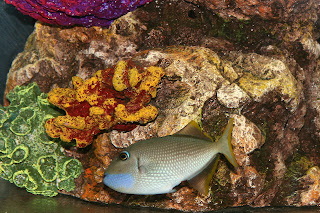After updating the firmware to v1.07 for the 3 different types of modules in the RKE system, I wasn't able to reset graphs. I even tried the "work around" solution with no success. Finally, as I navigated around the menu items, I tried out the "factory reset" option. Was that there before? I had to re-enter the few settings that I keep (two fans, some heaters, custom display). Then, wait for the data to come in.
This seems to have emptied out the memory successfully as I now can see new data appearing. And, the graphs are appearing properly.
Here's what happens to the temperature (with temp. probe measuring in the sump) during the day. I had sharper peaks yesterday since it was much hotter than today. The drop in peak shows the activity of the 1/5 horse power chiller.

Here is what happens to the pH (with probe measuring in the sump) over the day. In the morning, the pH starts around 8.0 and works up to 8.2 after the lighting intensifies.
Here you can see the pH fluctuation for several days. There's a small trend toward a lower pH which seems to level off near the end. I can't remember when I added a little Marine Buffer to help minimize the pH swing. I doubt that I'll be able to flatten this data with more buffer, but it's good to see that it's within acceptable range (pH 8.0 to 8.3).

I guess I can give the RKE v1.07 at least one thumb up for finally delivering (or bringing back) what was initially promised. Another thumb up will go after I move over my main pump, skimmer pump, more heaters and chiller control over to the RKE without failures.



























